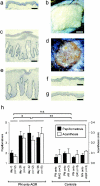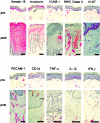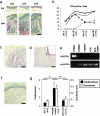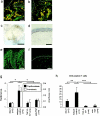Spontaneous development of psoriasis in a new animal model shows an essential role for resident T cells and tumor necrosis factor-alpha
- PMID: 14981113
- PMCID: PMC2213300
- DOI: 10.1084/jem.20031482
Spontaneous development of psoriasis in a new animal model shows an essential role for resident T cells and tumor necrosis factor-alpha
Abstract
Psoriasis is a common T cell-mediated autoimmune disorder where primary onset of skin lesions is followed by chronic relapses. Progress in defining the mechanism for initiation of pathological events has been hampered by the lack of a relevant experimental model in which psoriasis develops spontaneously. We present a new animal model in which skin lesions spontaneously developed when symptomless prepsoriatic human skin was engrafted onto AGR129 mice, deficient in type I and type II interferon receptors and for the recombination activating gene 2. Upon engraftment, resident human T cells in prepsoriatic skin underwent local proliferation. T cell proliferation was crucial for development of a psoriatic phenotype because blocking of T cells led to inhibition of psoriasis development. Tumor necrosis factor-alpha was a key regulator of local T cell proliferation and subsequent disease development. Our observations highlight the importance of resident T cells in the context of lesional tumor necrosis factor-alpha production during development of a psoriatic lesion. These findings underline the importance of resident immune cells in psoriasis and will have implications for new therapeutic strategies for psoriasis and other T cell-mediated diseases.
Figures




References
-
- Krueger, J.G. 2002. The immunologic basis for the treatment of psoriasis with new biologic agents. J. Am. Acad. Dermatol. 46:1–23. - PubMed
-
- Barker, J.N. 1991. The pathophysiology of psoriasis. Lancet. 338:227–230. - PubMed
-
- Gottlieb, S.L., P. Gilleaudeau, R. Johnson, L. Estes, T.G. Woodworth, A.B. Gottlieb, and J.G. Krueger. 1995. Response of psoriasis to a lymphocyte-selective toxin (DAB389IL-2) suggests a primary immune, but not keratinocyte, pathogenic basis. Nat. Med. 1:442–447. - PubMed
-
- Ellis, C.N., and G.G. Krueger. 2001. Treatment of chronic plaque psoriasis by selective targeting of memory effector T lymphocytes. N. Engl. J. Med. 345:248–255. - PubMed
Publication types
MeSH terms
Substances
Grants and funding
LinkOut - more resources
Full Text Sources
Other Literature Sources
Medical
Molecular Biology Databases

